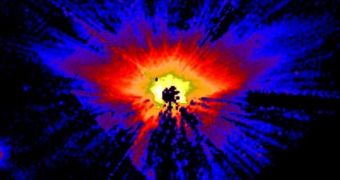It's common knowledge that, once a star forms from a collapsed cloud of cosmic gas and dust, it produces a protoplanetary disk around it. In this disk, large amounts of dust eventually clump together and give birth to meteors, asteroids, comets, moons and planets. But, in some telescope images, stars reveal disks of unusual and seemingly impossible shapes, a phenomenon for which astronomers have had no plausible explanation until now. A new study by scientists at the NASA Goddard Space Flight Center, in Greenbelt, Maryland, now proposes a simple and elegant explanation, ScienceDaily reports.
The team, led by astronomer John Debes, argues that the motion of the respective star through the interstellar gas – which permeates even the space between galaxies – is what causes the peculiar protoplanetary disk shapes. “The disks contain small comet- or asteroid-like bodies that may grow to form planets. These small bodies often collide, which produces a lot of fine dust,” he says, adding that, as the star “travels,” it bumps into gas clouds along its path. These collisions trigger the formation of winds, which in turn create turbulences in the disks.
“The small particles slam into the flow, slow down, and gradually bend from their original trajectories to follow it,” he adds. “This fine dust is usually removed through collisions among the particles, radiation pressure from the star's light and other forces. The drag from interstellar gas just takes them on a different journey than they otherwise would have had,” Debes shares. The team also reveals that finer particles are the most severely affected by these encounters, as they are the only ones with a mass sufficiently low to be subjected to the drag forces created by the dense gas clouds.
All of the stars that were analyzed for the new study with the Hubble Space Telescope are no more than 100 million years old, which is very little by cosmic standards. They are at about the same point in their development as the Sun was shortly after it was formed, and the planets we see today, including our own, began to develop. The paper detailing the new finds will appear in the September 1st issue of The Astrophysical Journal, the team adds.
There have been other explanations proposed for the peculiar shapes, Debes pinpoints, ranging from the existence of already-formed planets inside the disks, or maybe past encounters with other stars. “But we expect interstellar gas to be around – it's everywhere. It's important to consider the ecology of these debris disks before running to such conclusions, and this model explains a lot of the weirdly shaped disks we see,” the expert concludes.

 14 DAY TRIAL //
14 DAY TRIAL //